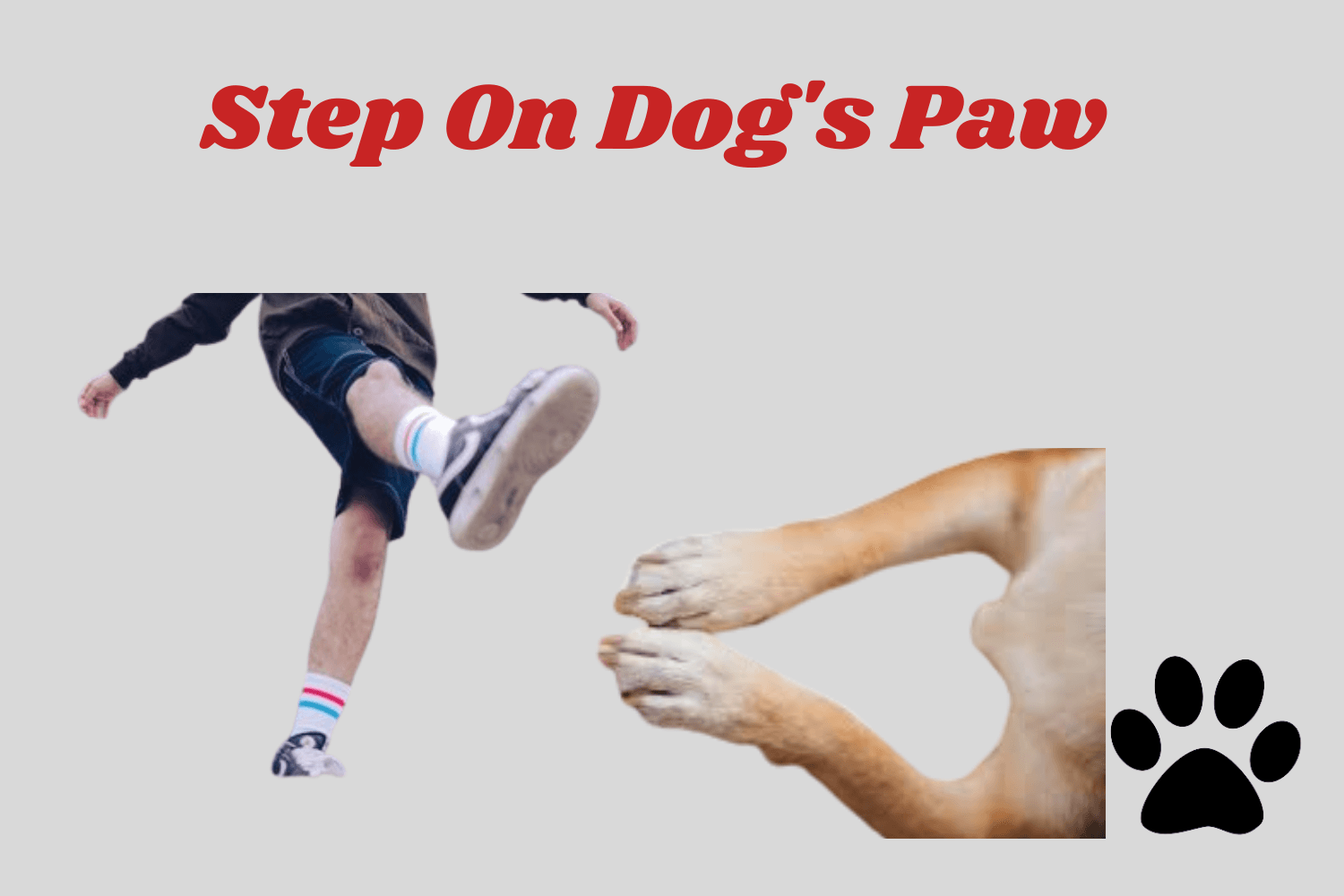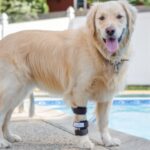Have you ever stepped on a dog’s paw and felt a surge of guilt and regret? If you have, you are not alone. A step on dog’s paw, many dog owners have experienced this unfortunate situation at least once in their lives, and some may have even faced serious consequences as a result.
A Step on a dog’s paw can cause physical and emotional pain for both the dog and the owner, and it is important to know how to prevent, recognize, and treat such injuries.
Let’s talk about the causes and consequences of stepping on a dog’s paw, the signs and symptoms of a dog’s paw injury, and the best practices and tips for avoiding and healing a dog’s paw injury.
By the end of this piece of knowledge, you will have a better understanding of how to care if you accidentally step on dog’s paw limping and avoid hurting them unintentionally.
Contents
- 1 The causes and consequences after step on your dog’s paw
- 2 Possible physical damages that can occur to the dog’s paw
- 3 The signs and symptoms of a dog’s paw injury
- 4 The First Aid and Home Remedies After stepping on a dog’s paw
- 5 Can you break a dog’s paw by stepping on it?
- 6 How Much Time Does a Dog’s Paw Take to Get Better?
- 7 Possible legal and financial implications that can arise from stepping on a dog’s paw
- 8 Conclusion
- 9 FAQs About Step On Dog’s Paw
The causes and consequences after step on your dog’s paw
Common scenarios and situations that can lead to stepping on a dog’s paw
- Walking or running with your dog without paying attention to where they are or where you are going
- Playing or cuddling with your dog on the floor or the bed and accidentally putting your weight on their paw
- Having multiple dogs or other pets in the house and stepping on one of them while trying to avoid the others
- Moving furniture or other objects around and not noticing your dog’s paw underneath them.
Possible physical damages that can occur to the dog’s paw
- Abrasions or scrapes that can remove the skin or fur from the paw and expose the underlying tissue
- Punctures or holes that can pierce the paw and create a wound that can bleed or get infected
- Lacerations or tears that can split the paw and damage the muscles, tendons, or ligaments
- Sprains or strains that can twist or stretch the paw and injure the joints, bones, or cartilage
Potential emotional impacts that can affect the dog’s behavior
- Fear or anxiety that can make the dog nervous or scared of being around you or other people
- Aggression or defensiveness that can make the dog bite or snap at you or other animals
- Mistrust or resentment that can make the dog lose their bond or loyalty to you or their family
The signs and symptoms of a dog’s paw injury
If you are worried about and fell in this situation, I stepped on my dog’s paw, so It is essential to be able to recognize the signs and symptoms of a dog’s paw injury, as they can vary depending on the severity and type of the injury.
1- Some of the common indicators of a dog’s paw injury are:
- Limping or favoring one leg over the other
- Licking or chewing the paw excessively
- Swelling or inflammation of the paw or the toes
- Bleeding or discharge from the paw or the nails
- Redness or discoloration of the paw or the skin
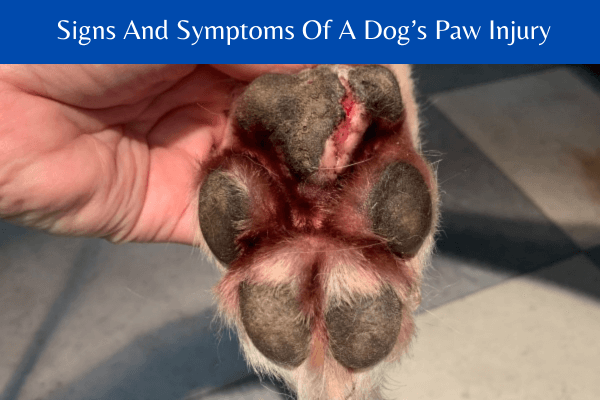
2- The signs and symptoms of a dog’s paw injury can also differ
It also depends on the type of injury, such as abrasions, punctures, lacerations, or sprains.
Some of the differences are:
- Abrasions or scrapes can cause superficial wounds that may not bleed much but can be painful and prone to infection.
- Punctures or holes can cause deep wounds that may bleed heavily but can be hard to detect and clean.
- Lacerations or tears can cause large wounds that may bleed profusely but can be easier to see and treat.
- Sprains or strains can cause internal injuries that may not bleed at all but can be very painful and cause lameness or stiffness
3- To assess the extent and seriousness of a dog’s paw injury
It is important to examine the paw carefully and look for signs of broken bones, infections, or foreign objects.
Some of the steps are:
- Gently touch and move the paw and the toes to check for any fractures or dislocations.
- Clean and inspect the paw and the nails to check for any infections or pus.
- Use a magnifying glass or a flashlight to check for any foreign objects or debris embedded in the paw or the wound
4- The best practices and tips for avoiding and healing a dog’s paw injury
Several steps can be taken to prevent and treat a dog’s paw injury, such as being careful, attentive, and prepared.
Some of the preventive measures that can reduce the risk of stepping on a dog’ are:
- Training your dog to stay away from your feet and follow your commands. You can teach your dog to sit, stay, or move when you ask them to, using positive reinforcement and treats. This can help your dog avoid getting in the way of your steps and prevent accidents.
- Use a leash when walking your dog outside or in crowded places. A leash can help you control your dog’s movements and keep them close to you. This can prevent your dog from wandering off or running into other people or objects that might hurt their paws.
- Improving the lighting in your home or outside areas where you walk your dog. Poor visibility can make it hard to see your dog’s paw and increase the chances of stepping on it. By using brighter lights or flashlights, you can improve your vision and avoid stepping on your dog’s paw.
- Wear appropriate footwear when walking your dog. Shoes that are too big, too small, or have heels can make it difficult to balance and maneuver around your dog. By wearing comfortable and flat shoes, you can reduce the risk of tripping or slipping and stepping on your dog’s paw.
Further, Read About Dog Health-Related Problems and Their Solutions
My Dog Needs Stitches But I Can’t Afford It
My Dog Jumped After Being Spayed
The First Aid and Home Remedies After stepping on a dog’s paw
the first aid and home remedies that can help heal a dog’s paw injury are:
- Cleaning the paw and the wound with warm water and mild soap. This can help remove any dirt or bacteria and prevent infection.
- Bandaging the paw and the wound with sterile gauze and tape. This can help protect the paw and the wound from further damage and contamination.
- Icing the paw and the wound with a cold compress or a bag of frozen peas. This can help reduce the swelling and the pain.
- Elevating the paw and the wound above the heart level. This can help improve the blood circulation and the healing process.
The paw or the wound is showing signs of infection
The paw or the wound is showing signs of infection such as pus, odor, or fever. The paw or the wound is not healing or improving after a few days
The dog is showing signs of distress, such as loss of appetite, lethargy, or depression.
Can you break a dog’s paw by stepping on it?
Might you at any point break a canine’s paw by stepping on it? The response is indeed, you can break a canine’s paw by stepping on it. The gamble of a break is significantly higher if it’s a dog’s paw or when the effect is perfect.
The bones in a little dog’s foot are still exceptionally delicate, subsequently a sufficiently extraordinary power from your feet or shoe can cause serious inside injury.
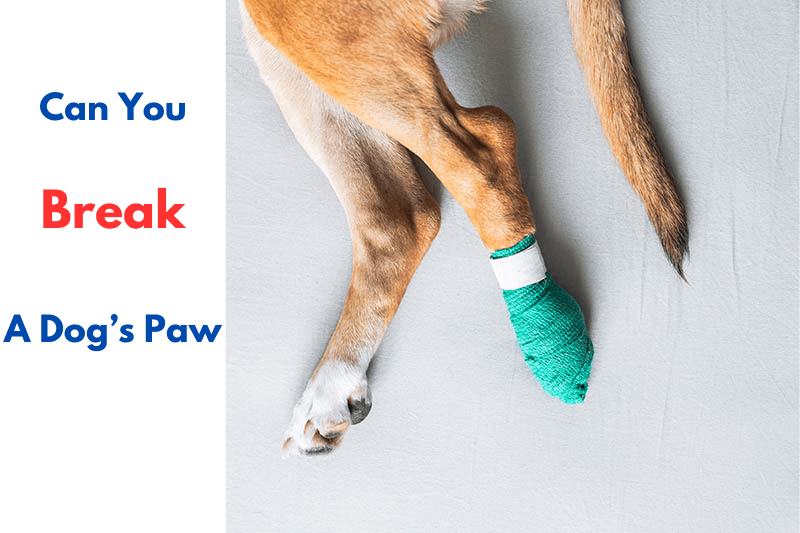
1- signs that indicate a broken paw of the dog
Some of the signs that indicate a broken paw are:
- Excessive bleeding or discharge from the paw or the nails
- Swelling or inflammation of the paw or the toes
- Limping or favoring one leg over the other
- Holding their head below their shoulders
- Vocalization or whining
2- What to do If you suspect that your dog has a broken paw,
you should seek professional help and consult a veterinarian as soon as possible. They can diagnose the cause of your dog’s pain and recommend appropriate treatments.
Some common treatments for a broken paw are:
- X-ray or splint to help the paw heal properly
- Antibiotics or painkillers to prevent infection and reduce inflammation
- Surgery or amputation in extreme cases
3- How to prevent breaking your dog’s paw by stepping on it,
you should be careful, attentive, and prepared.
Some of the preventive measures that can reduce the risk of stepping on your dog’s paw are:
- Training your dog to stay away from your feet and follow your commands
- Using a leash when walking your dog outside or in crowded places
- Improving the lighting in your home or outside areas where you walk your dog
- Wear appropriate footwear when walking your dog.
How Much Time Does a Dog’s Paw Take to Get Better?
- The healing time for a dog’s paw depends on the type and severity of the injury, as well as the age and health of the dog.
- Some of the common types of paw injuries are abrasions, punctures, lacerations, sprains, and fractures.
- Some of the factors that can affect the healing process are infection, inflammation, movement, and blood supply.
- Abrasions are superficial wounds that can heal in about 7 to 9 days, while punctures, lacerations, and sprains can take up to 21 days to heal, depending on the depth and extent of the damage. Fractures are more serious and can take at least a month to heal, but may take longer if there are complications or if the dog does not follow the activity restrictions.
How to help your dog’s paw heal faster and prevent infection,
you should follow these steps:
- Clean the paw and the wound with warm water and mild soap, and remove any foreign objects or debris
- Bandage the paw and the wound with sterile gauze and tape, and change the bandage regularly
- Apply ice or a cold compress to the paw and the wound to reduce swelling and pain
- Elevate the paw and the wound above the heart level to improve blood circulation and healing
- Restrict your dog’s activity and keep them off hard or rough surfaces
- Use a paw protector or bootie to cover the paw and the wound
- Consult your veterinarian and follow their instructions on medication, treatment, and care.
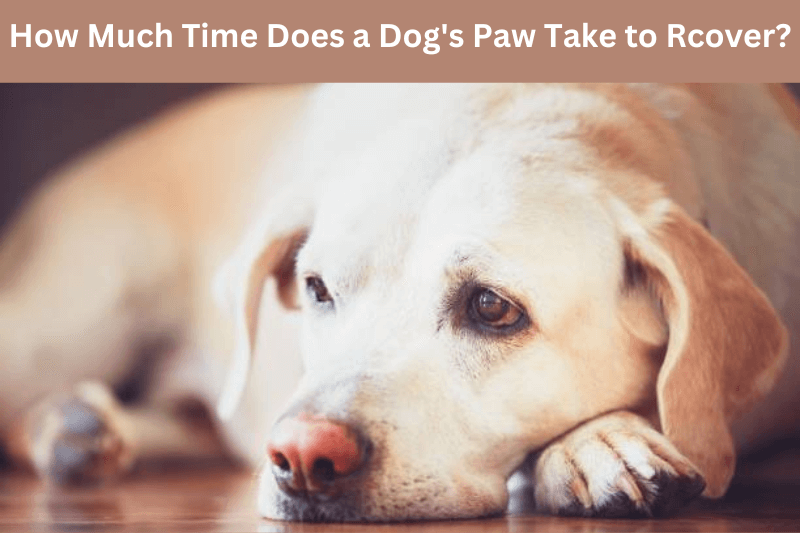
If your dog’s paw shows signs of infection, such as pus, odor, fever, or increased pain, or if the wound does not heal or improve after a few days, you should seek professional help and consult your veterinarian as soon as possible.
They can diagnose the cause of your dog’s pain and recommend appropriate treatments, such as antibiotics, painkillers, surgery, or amputation.
Possible legal and financial implications that can arise from stepping on a dog’s paw
- Lawsuits or claims from other parties that can accuse the owner of negligence, abuse, or cruelty
- Fines or penalties from the authorities that can enforce the animal welfare laws and regulations
- Veterinary bills or expenses from the treatment and care of the dog’s paw injury.
Conclusion
step on dog’s paw, If you are worried about your act; We explained the causes and consequences of when Accidentally stepping on your dog’s paw, the signs and symptoms of a dog’s paw injury, and the best practices and tips for avoiding and healing a dog’s paw injury.
I hope that by reading this essay, you have gained a better understanding of how to care for your dog’s paws and avoid hurting them unintentionally.
Dogs are loyal and loving companions, and they deserve our respect and compassion. The next time you walk or play with your dog, remember to be careful, attentive, and prepared, and to treat their paws as gently as you would treat your own.
FAQs About Step On Dog’s Paw
Q 1: What are the signs of a dog’s paw injury?
A. Common indicators include limping, excessive licking or chewing, swelling, bleeding, and redness after you step on dog’s paw.
Q 2: How can I assess the severity of my dog’s paw injury?
A. Carefully examine the paw, checking for fractures, infections, or foreign objects. Look for signs like fractures, infections, or foreign objects, and gently touch and move the paw and toes to check for damage.
Q 3: What are the first aid steps after stepping on a dog’s paw?
A. Clean the wound with mild soap and water, bandage it, apply ice to reduce swelling, and elevate the paw above heart level.
Q 4: Can I break a dog’s paw by accidentally stepping on it?
A. Yes, it is possible to break a dog’s paw, especially if the impact is forceful or if the dog is small and delicate.
Q 5: How long does it take for a dog’s paw to heal?
A. Healing time varies based on the injury type: abrasions take about 7-9 days, while more severe injuries like fractures can take at least a month, possibly longer with complications.

